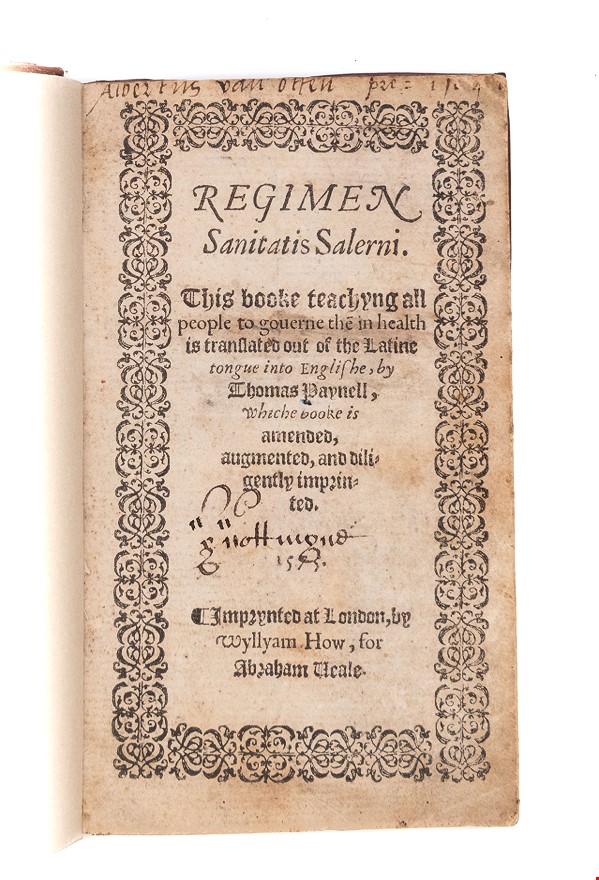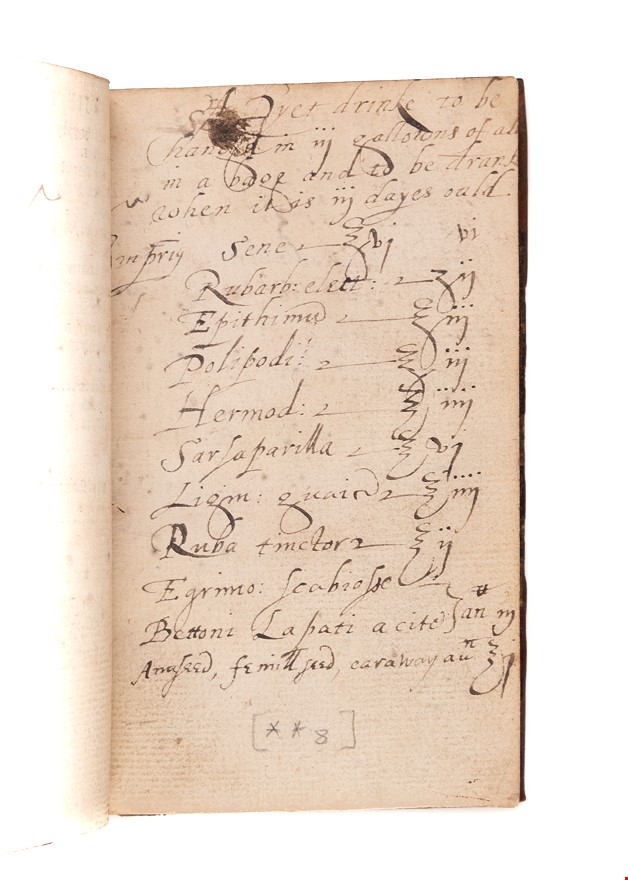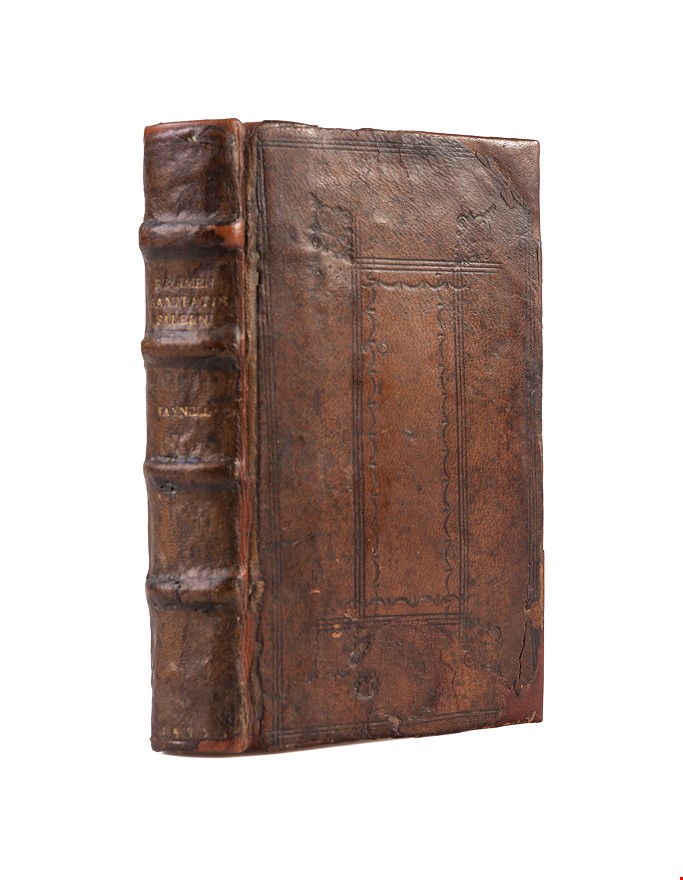Regimen Sanitatis Salerni
PAYNELL Thomas translator ([1575].)
£12500.00
Please contact us in advance if you would like to view this book at our Curzon Street shop.
THE REGIMEN OF THE SCHOOL OF SALERNO - A BRISTOL SURGEON'S COPY
This booke teachyng all people to governe the[m] in health is translated out of the Latine tongue into Englishe, by Thomas Paynell, whiche booke is amended, augmented, and diligently imprinted 1575.
London: by Wyllyam How, for Abraham Veale. [1575]
Sixth Edition of ten of this translation. Small 8vo. [Text: 136 x 89mm]. [16 (**8 blank)], i-cxxvi, ‘cxxvi’, cxxvii-clxvii leaves. Title-page and the blank leaf **8 a little dusty, old repair to a closed tear in **1 touching a few lines of text and in X2, a very few of the many sidenotes just shaved by the binder (see X1v and X6v for the worst case), a couple of minor spots and marks in places, grubby mark to M2.
Late 17th/early 18th-Century sheep, panelled in blind (worn, rebacked, remains of old spine laid down, later lettering in gilt to spine, extensive repairs to corners, edges and headcaps, red sprinkled edges, new endpapers).
STC 21601 (BL, Bodley, Cambridge UL [x 2; one ex Peterborough Cathedral], Cashel Cathedral Library (University of Limerick), National Library of Ireland, National Library of Scotland, Royal College of Surgeons, St Andrews UL; University of Chicago, Folger (x3), Huntington, University of Kansas, New York Academy of Medicine, US National Library of Medicine). The last copies of this edition sold at auction were in 1988, 1983, and 1958.
The Regimen Sanitatis Salernitanum comprises the lengthy commentary of (Pseudo-) Arnaldus or Arnoldus de Villa Nova (c. 1235/40-1311) on a medieval didactic poem on the preservation of health of uncertain date and of uncertain origin but attributed to John of Milan (Johannes de Mediolano) which was by legend written for Robert II (Curthose), Duke of Normandy (1051-1134; r. 1087-1106). The poem was ascribed generally to the medical school at Salerno in Italy which had been founded in the 9th Century teaching a synthesis of Western Classical, Arabic and Persian medicine and lasted until 1811. Although it may not have originated at Salerno the name was attached to the text from an early date and it gained the School of Salerno an international renown in the Middle Ages that lasted for centuries. It was first printed at Louvain by Johannes de Westfalia between 1477 and 1483 and reprinted countless times and translated into numerous European languages.
Thomas Paynell (d. 1564?), a canon of the Augustinian Priory at Merton in Surrey until the Dissolution and then, probably, rector of Cottingham in Yorkshire and of All Hallows, Honey Lane, London, was a prolific translator from Latin (see ODNB). His translation of the Regimen retains the original verses in Latin but translates the extensive commentary. It was first published by Thomas Berthelet in 1528 (STC 21596; BL x2 and John Rylands only). Four further editions appeared before the present 1575 edition (1530, 1535, 1541, 1557) and four after (1597, 1617 [3 issues], 1634 [with an added short discourse of fish], 1649[/50]. The first four editions were printed by Berthelet and the next two, 1557 and the present, for Andrew Veale (Vele) fl. 1550?-95. From 1617 the Latin verses also had English translations added by Philemon Holland.
This edition reprints Paynell’s dedication of the 1557 edition to William Paulet, 1st Marquess of Winchester, Lord Treasurer (c. 1483/5-1572). The first four editions were dedicated to John de Vere, 15th Earl of Oxford, Lord Great Chamberlain (c. 1482-1540) - only the names are changed - the text of the dedication remained the same.
The Regimen teaches a Galenic system of physical health ruled by the humours and recommends a life of moderation as the opening lines of the poem, here in the 1617 translation by Philemon Holland, suggest:
"All Salerno Schoole thus write to Englands King,
And for mans health these fit advises bring.
Shunne busie cares, rash angers, which displease;
Light supping, little drinke, doe cause great ease.
Rise after meate, sleepe not at after noone,
Vrine and Natures neede, expell them soone.
Long shalt thou live, if all these well be done."
The principal sources for the commentary attributed to (Pseudo-)Arnaldus or Arnoldus de Villa Nova are the writings attributed to the Romano-Greek physician Galen (2nd Century AD), which largely survived through their translation into Arabic and subsequent re-translation into Latin, and there are frequent references to the writings of the Persian physicians Avicenna (Ibn Sina, 980-1037) in particular, and Averroes (Ibn Rashid, 1126-1198), and the Andalusian Rasis (Abu Bakr Muhammed Zakariyya, 834-925). All these are referenced in the many sidenotes.
The index (reprinting the improved version in Veale’s 1557 edition) gives a sense of the wide-ranging scope of the text and the vast array of medical ailments that the work covers. There are numerous chapters on diet including the quality and quantity of food - “eat and drinke soberly: for eating and drinkinge excessively, causeth us to be unlusty, drousie, and slouthfull, hurtinge and infeeblinge the stomacke” (f. iir). There are also sections on bloodletting, gout, hunger, urinating, sea sickness, mental health (“care of mynde”) and melancholy, and medical properties connected to specific foodstuffs such as bread (“although that hotte breade in the Regiment of Health be unholsome to eate: be unholsome to eate: yet the smell thereof is right holsome: for it releveth one in a sounde: and it is possible, that some folks may live by the smell of new breade.” f. lxiiir), bacon, butter milk, brains (“the best braynes be of foules that flee, and properlye aboute mountaines.”, f. xxxivr), quails (“they are not to be praysed, neither for their nourishement nor for digestion.” f. lxxir), camel’s milk, grapes, figs, nuts, eels, eggs, garlic, honey, mutton, pepper, onions, red wine, white wine (“why white wines provoketh to pisse so” f. xxixr), sage, and vinegar.
Early Provenance: Albertus Van Otten (fl. 1574-?94), surgeon in Bristol, with his ink signature “Albertus van otten pre= 1 [s 4d ?]” at the head of the title (slightly shaved). Master Albertus van Otten was in Bristol when he witnessed the will of Henry Berchont, merchant, of Horne, Holland, made on 9 December 1591 (Jean Vanes, ed., Documents illustrating the Overseas Trade of Bristol in the Sixteenth Century, Bristol Record Society, 1979, p. 70). Albert Van Otten was admitted burgess (made a freeman) of Bristol as a Surgeon on 30 Sept. 1580 and on 12 Oct. 1594 "Albert Van Ottey" stood as Patron for the admission as burgess of Henry Roberts, Gentleman, perhaps his son-in-law, see below (Index to the Bristol Burgess Books Volumes 1 to 21 1557-1995, 2005).
In Bristol there are records of the baptism of John, son of Albertus Vanotten on 13 May 1574, the baptism of William, son of Albert Vanotten on 20 Aug. 1588 and his burial on 25 Aug. 1588. The marriage of ‘Johan Vanotten’, widow, to Henry Roberts on 6 Aug. 1594. John van Otten, yeoman, son of Albert van Otten, surgeon, was made a burgess (admitted to the freedom) of Bristol on 13 July 1605 (Roger Price, "Five Hundred 'Missing' Bristol Burgesses: 1599-1607" (2009).
We have traced three other books with Albertus van Otten’s signature: John Foxe, An abridgement of the booke of Actes and monumentes, ed. Timothy Bright (London, 1589) in Cambridge University Library (Keynes R.110); Johann Jacob Wecker, De secretis libri XVII (Basel, 1588) in Queen’s College, Cambridge (H.19.23); Louis Regnier de la Plance (“Francois de L’Isle”), A Legendarie conteining an ample discourse of the life and behaviour of Charles Cardinal of Lorraine, and of his brethren, of the house of Guise ([Geneva?], 1577), was in the Fox Pointe Manor [Howard R. Knohl], sale, Forum Auctions, 10/7/2019, lot 32 (unsold). The last was once in the library of the Royal College of Physicians.
It is probable that Albertus was one of a family of physicians, one of whom has an ODNB entry (Otthen, Hippocrates). He was the aptly-named Hippocrates d’Otthen, MD (Montpelier; incorporated at Oxford on 16 March 1605 or 12 June 1609). He was born c. 1560 at Enghien, Hainault, then in the Spanish Netherlands, though the family were originally either from Holstein (Holsatia) in Denmark or Alsace (Alsatia); accounts vary though the latter seems more likely. His father was a physician to the Holy Roman Emperor. He came to England, perhaps with his father and perhaps at the request of Queen Elizabeth, and was admitted licentiate of the College of Surgeons in London (4 July 1589), “vir doctus et practicator bonus.” He served as physician to the Earl of Leicester in England and the Low Countries, to the Earl of Essex in France and on the voyage to Cadiz in 1596, to Lord Mountjoy in Ireland, and to the Earl of Hertford on his 1604 Embassy to Albert VII, Archduke of Austria and Governor-General of the Spanish Netherlands. He died on 13 Nov. 1611 and was buried in St Clement Danes Church where a monument recorded his career at length and is the main source for his ODNB entry.
David Pearson’s Book Owners Online includes a record of the probate inventory of one Herman van Otten, surgeon, of Banbury who was buried on 17 Aug. 1611. It included “seven of the bigger books” (valued at 13s 4d) and “threescore and five smaller books” (£1 13s 4d), beside fifteen “instrumentes of surgerie” (16s), a ‘salvatory’ or box for ointments (6s 8d), a brass mortar and pestle (2s 6d), a lancet and pair of knives (6d) and a still (8s) (J. Gibson, ed, Banbury wills and inventories 1591-1620, 1985, p. 221).
James Vanotten (Jacobus van Otten) was licensed on 24 Nov. 1601, with Nicholas Bowlden, by the Barber-Surgeons Company to practise in the City of London for “three months next ensuinge onely for the couchinge of the catarack, cuttinge for the rupture, stone, and wenne” for a fee of 20 shillings per month (Sidney Young, Annals of the Barber-Surgeons, 1890, p. 324). He was presumably the same James Van Otten, “Homo. Belga. Chyrurgus, privilegiatus admiotted to practise surgery at Oxford on 23 May 1620 and matriculated as a ‘privilegiatus’ (privileged person)) on 6 April 1621, aged 53 (Foster, Alumni Oxonienses). Anthony Wood thought he was, “the same I suppose with Jac. Otten who was a student in physic in this university, for the sake of the public library an. 1604, and after.” (Wood, Athenae Oxonienses). He died at Oxford on 1 March 1622, when he was the subject of a poem by William Strode, beginning ‘The first day of this month the last hath bin | To that dear soule. ...’) (Strode, Poetical Works, ed. Percy Dobell, 1907).
Later Provenance: Beside Albertus van Otten’s inscription there is an early ink name on the title-page, ? “H nottingne” and three ink inscriptions on the verso of the title: “Thomas Prince oweth this booke 16ii” (crossed-through), “... [?] Deere [/ Deene] oweth this booke 1635” (heavily deleted), “William [?] Meham his book 1651”. 17th-Century ink signature on the blank leaf *88v “G Mathew #”.
“G Mathew #”. There are also two 17th-Century manuscript medical remedies written in ink on the blank **8 - “A dyet drinke to be hanged in iii gallons of al[e] in a bag and to be drank when it is iii days ould” listing 11 ingredients and quantities, and “To purge the ba[c]ke” listing ingredients to be “fiat bolus in saccharo” (a ‘bolus’ is a ball somewhat bigger than a pill, in sugar here).
Modern Provenance: Dr John Cymerman Craig (1920-2012), Professor of Chemistry and Pharmaceutical Chemistry at UC San Francisco, collector of and dealer in early books on cookery and diet. There are a few neat pencil markings by him in the text. Craig’s collection was exhibited at the Bancroft Library, Berkeley, California with a catalogue, Four Hundred Years of English Diet & Cookery: A Selection of Books Printed Between 1541 & 1939, in 1987. Sold to a private collector in 2007, collector’s own very small red ink stamp of three dots in the lower blank margin of the verso of the final leaf.
Stock Code: 239824






